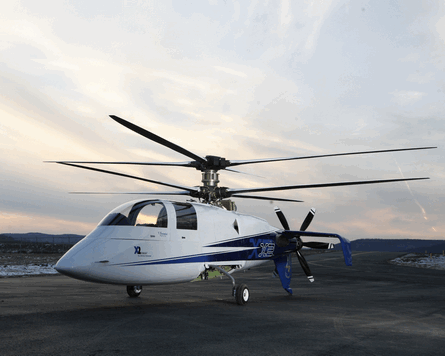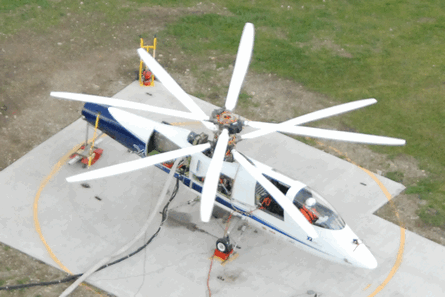Sikorsky offered a tantalising glimpse of a high-speed future for helicopters when it announced the X2 programme in 2005 – a compound helicopter capable of cruising at 250kt and packed full of new technologies. Now the demonstrator is almost ready to fly.
Speed equals time and time equals money. When the Sikorsky design team conceived X2 the challenges were complex but the principle was simple – fly faster and the market will be there.
Three years on from going public on the concept of a high speed compound helicopter the programme is at a critical phase. Ground runs with rotor blades installed and spinning have been completed for the first time and Sikorsky says first flight of the demonstrator is “imminent”.
It will be well into the next decade before customers, whether civil or military, are able to fly any of what the company envisages as a family of aircraft built around an X2 suite of technologies. Between now and then is a significant development challenge for the X2 team based at Sikorsky subsidiary Schweizer in New York state.
 |
|---|
© Sikorsky |
“The flight test programme will be in four stages,” says Jim Kagdis, programme manager, advanced programmes. At Schweizer we will move from the hover out to about 40kt, then transition the programme to West Palm Beach in Florida to take the aircraft from 40kt to 120kt, then 120kt to 180kt. Finally, we’ll complete the final phase out to our ultimate goal of a 250kt cruise. I would expect to be at that point within the next two years.”
Sikorsky has so far completed 14 hours of ground runs with dynamic systems and is now in the final build phase prior to first flight. “It’s actually been pretty smooth,” says Kagdis. “We had the benefit of not being completely new to the idea of a coaxial design.” The X2’s prime predecessor, the XH-59A advancing blade concept, was built by Sikorsky and part-funded by NASA and other parties in the early 1970s.
The goal at the time was to test the concept that rigid counter-rotating main rotors, where the advancing blade on each side produces lift while both retreated blades are feathered, could be used to reduce drag and tip velocities to produce higher cruise speeds. Although it did just that, the technical limitations around high vibration, mechanical control mechanisms and fuel-thirsty powerplant proved insurmountable at that time.
In the interim the required technologies were matured largely thanks to research on military contracts, not least the Boeing Sikorsky RAH-66 Comanche, whose development as an armed reconnaissance helicopter included a vast research programme prior to its termination by the US military in 2004.
This time around Sikorsky is sole-funding the X2 development and is learning from past experience on where the potential pitfalls are. Kagdis explains: “Technology has moved on a huge amount in the interim period. On X2 we are using composite materials, we will integrate fly-by-wire, have all composite blades and also active vibration control. Integration of these types of technologies makes a huge difference when you are developing such an advanced concept.”
Kagdis says the pusher propeller, which works with the counter-rotating coaxial main rotors, will be integrated but not operational for early flight test. He also points to the rapid prototyping capabilities of Schweizer which have helped to manage the development schedule effectively and keep a lid on costs.
Sikorsky unveiled the two place demonstrator at HAI in Texas in February and since then has amassed important market feedback on the concept. The offshore oil market is a key potential market for X2, says Kagdis, because of the potential to increase the productivity of aircraft which currently might only be able to complete three missions per day. “Time-sensitive missions are where you can really see the value of the extra speed,” he says. The offshore oil variant would likely be in the 15-19 seat range.
Sikorsky is also targeting the emergency medical services (EMS) market where operators have a specific requirement for speed to reach accident sites and subsequently to transport casualties for trauma care as rapidly as possible.
On the military side Sikorsky envisions an X2-sized armed helicopter that could fly escort for the Bell Boeing V22 Osprey and also as a Boeing Little Bird replacement for special operations missions, operating at long distances off carriers and once in theatre able to fly with the lower speed and agility of a traditional helicopter.
|
|
|---|
© Sikorsky |
The fly-by-wire (FBW) aspect of X2 is likely to have wider implications for Sikorsky, which indicated at HAI that it plans to harness FBW and autonomous flight to improve the safety and utility of future helicopters. Sikorsky president Jeff Pino states that Sikorsky has an internal goal to fly a Black Hawk with an option for ‘one pilot’, ‘two pilot’ or ‘no pilot’ operations as early as 2011.
In the short term the focus will remain on speed, where the prospect of adding 100kt to current cruise performance for existing helicopters will ensure that the development of X2 is followed almost as closely in the rest of the industry as it is within Sikorsky.
Source: Flight International
























